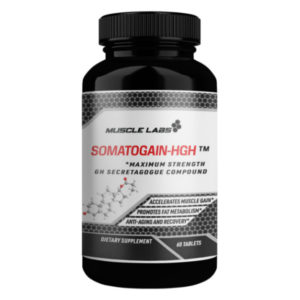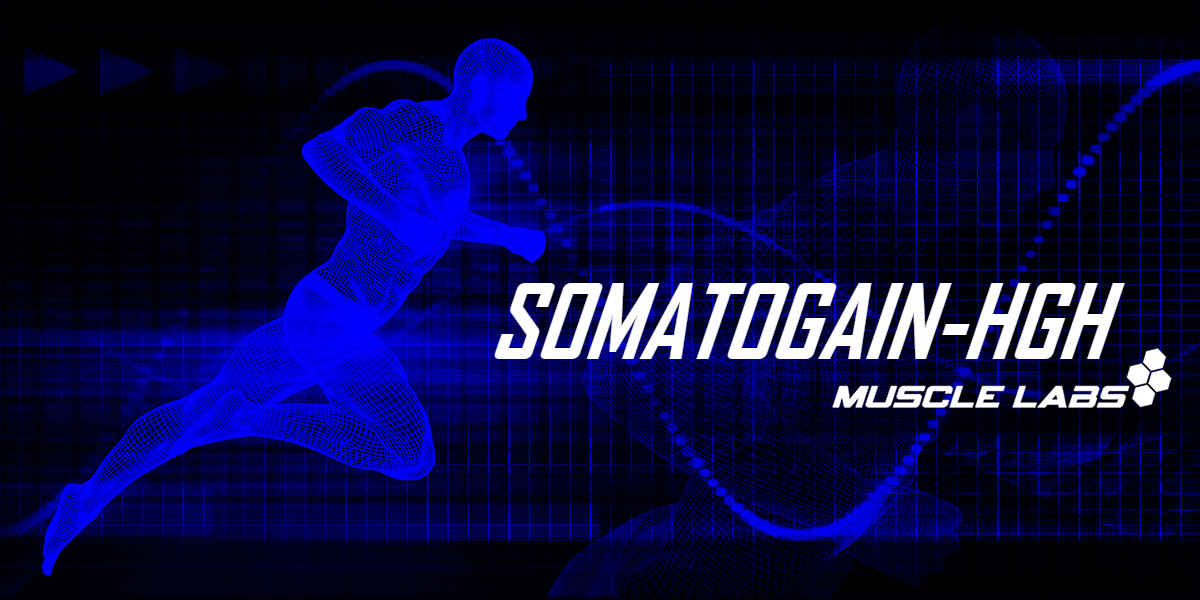Table of Contents
Somatogain-HGH Human Growth Hormone Secretagogue
Pro bodybuilders, world-class powerlifters, Olympic competitors, and professional athletes alike have relied on Anabolics for the better part of a decade. Find out how Somatogain-HGH works.
There are primarily two theories as to how GH exerts its growth promoting effects. The first theory, called the †Dual Effector theory (Green, 1985). The second theory, called the ††Somatomedin (“mediator of growth”) Hypothesis. Both theories are fairly strait forward. Let’s start with the Dual Effector theory.
The Dual Effector
The Dual Effector theory establishes that GH itself has anabolic effects directly on body tissues. This theory has been supported by studies looking at the effects of injecting GH directly into growth plates. Genetically altered strains of mice have also help to support this theory.
When comparing mice that genetically over express GH and mice that over express insulin-like growth factor-1 (IGF-1), GH mice are larger. Those who support the dual effector theory site this evidence. Interestingly, when IGF-1 antiserum (it destroys IGF-1) is administered concomitantly with GH, all of the anabolic effects of GH are abolished. Clearly IGF-1 has got to be involved somewhere between the pituitary and the target tissue (i.e. muscle). The Somatomedin hypothesis clears things up somewhat.
Somatomedin Hypothesis
The Somatomedin hypothesis states that GH exerts its growth promoting effects through IGF-1. More specifically, GH is first released from the pituitary and then travels to the liver and other peripheral tissues where it causes the synthesis and release of IGFs. IGFs work as endocrine growth factors, meaning that they travel in the blood to the target tissues after being released from cells that produced it, specifically the liver in this case.
 Many studies have been performed showing that animals that are GH deficient, systemic IGF-1 infusions lead to normal growth. Admittedly, the effects are similar to those observed after GH administration. In fact, additional studies have shown IGF-1 to be greatly inferior as an endocrine growth factor requiring almost 50 times the amount to exert that same effects of GH.†††
Many studies have been performed showing that animals that are GH deficient, systemic IGF-1 infusions lead to normal growth. Admittedly, the effects are similar to those observed after GH administration. In fact, additional studies have shown IGF-1 to be greatly inferior as an endocrine growth factor requiring almost 50 times the amount to exert that same effects of GH.†††
IGF-1
Recently rhIGF-1 has become widely more available and is currently approved form the treatment of HIV associated wasting. This increased availability allowed testing of this hypothesis in humans. Studies in human subjects with GH insensitivity have consistently validated the somatomedin hypothesis (Rank, 1995; Savage, 1993). These results indicate that although IGF-1 might be the mediator of GH effects, it’s not as simple as just getting the liver to release IGF-1.
So Which Theory is Best?
So the main difference between these two theories is that the Dual effector theory states that GH doesn’t necessarily need IGF-1 to work, the Somatomedin hypothesis insists it does. In reality both theories are correct.
It’s just that the Somatomedin hypothesis focuses on “circulating” IGF-1, the Dual Effector theory recognizes that although IGF-1 is still the active hormone, it doesn’t have to come from the blood (liver), it can be produced on location by the very cells that use it.
In summary, by combining the Dual Effector theory and the Somatomedin hypothesis there are three main mechanisms by which GH makes things grow. First, the effects of GH on bone formation and organ growth are mediated by the endocrine action of IGF-1.
As stated in the Somatomedin hypothesis, GH, released from the pituitary, causes increased production and release of IGF-1 into the general circulation. IGF-1 then travels to target tissues such as bones, organs, and muscle to cause anabolic effects.
Further Findings
Second, GH regulates the activity of IGF-1 by increasing the production of binding proteins that increase the half-life of IGF-1 from minutes to hours. Circulating proteases then act to break up the binding protein/hormone complex thereby releasing the IGF-1 in a controlled fashion over time. GH may even cause target tissues to produce IGFBP-3 increasing its effectiveness locally.
Third, GH may influence the activity of IGF-1 on an autocrine/paracrine level. Autocrine means that a hormone has an effect on the cell that produced it, paracrine means to have an effect on the “cell(s)” next to it as well. A completely localized effect, not dependent on the blood stream to carry things where you want them.
Muscle growth from weight training is the result of IGF-1 being produced by the muscle cells themselves, not the liver. In fact, IGF-1 form the liver is genetically different from IGF-1 produced in your muscles. This information should explain why using IGF-1 systemically (from the blood stream) has been a hit and miss proposition.
In order to sufficiently address the role of GH and IGF-1 in muscle growth, we need to explore the mechanism of not only IGF-1’s autocrine/paracrine actions, but also the mechanisms of muscle growth itself.
How Do Muscle Tissue Regenerate
The ability of muscle tissue to constantly regenerate in response to activity makes it unique. Ability to respond to physical/mechanical stimuli depends greatly on satellite cells. Satellite cells are muscle precursor cells.
You might think of them as “pro-muscle” cells. They are cells that reside on and around muscle cells. These cells sit dormant until called upon by growth factors such as IGF-1. Under the influence of IGF-1 these cells divide (proliferate) and genetically change (differentiation) into cells that have nuclei identical to those of muscle cells. These new satellite cells with muscle nuclei are critical if not mandatory to muscle growth.
Muscle Cells and Nuclei
Without the ability to increase the number of nuclei, a muscle cell will not grow larger and its ability to repair itself is limited. The explanation for this is quite simple. The nucleus of the cell is where all of the blue prints for new muscle proteins come from.
The larger the muscle, the more nuclei you need to maintain protein synthesis. There is a “nuclear to volume” ratio that cannot be overridden. Whenever a muscle grows in response to mechanical overload (i.e. weight training) there is a positive correlation between the increase in the number of myonuclei and the increase in muscle cell’s cross sectional area (CSA).
When satellite cells are prohibited from donating new nuclei, overloaded muscle will not grow (Rosenblatt,1992 & 1994; Phelan,1997). So you see, one important key to exercise induced muscle growth is the activation of satellite cells by growth factors such as IGF-1.
Injecting IGF-1
Few people realize that you can inject a muscle with IGF-1 and it will grow! Studies have shown that, when injected locally, IGF-1 increases satellite cell activity, muscle DNA content, muscle protein content, muscle weight and muscle cross sectional area (Adams,1998).
I’m not really sure why someone would choose to inject oil instead of IGF-1. Oil gives you lumps and causes your peers to make jokes about you behind your back. IGF-1 just makes the muscle grow and leaves people wondering how you brought up those lagging rear delts.
Science and IGF-1 Research
Scientists are now figuring out the signaling pathway by which mechanical stimulation. IGF-1 activity leads to all of the above changes in satellite cells and muscle DNA content. Also, muscle protein content, muscle weight and muscle cross sectional area just outlined above.
This research, stemming from studies done to explain cardiac hypertrophy. Involving a muscle enzyme called calcineurin. Calcineurin, a phosphatase enzyme activated by high intracellular calcium ion concentrations (Dunn, 1999). Note that overloaded muscle, characterized by chronically elevated intracellular calcium ion concentrations.
Other recent research has demonstrated that IGF-1 increases intracellular calcium ion concentrations leading to the activation of the calcineurin signaling pathway, and subsequent muscle fiber hypertrophy (Semsarian, 1999; Musaro, 1999). I am by no means a geneticist so I hesitated even bringing this research up. To avoid confusion I will enlist the help of the people doing the research.
The researchers involved in these studies have explained it this way, IGF-1 as well as activated calcineurin, induces expression of the transcription factor GATA-2, which accumulates in a subset of myocyte nuclei, where it associates with calcineurin and a specific dephosphorylated isoform of the transcription factor nuclear factor of activated T cells or NF-ATc1.
Thus, IGF-1 induces calcineurin-mediated signaling and activation of GATA-2, a marker of skeletal muscle hypertrophy. Cooperates with selected NF-ATc isoforms to activate gene expression programs leading to increased contractile protein synthesis and muscle hypertrophy.
References
†Green, 1985
††Daughaday, 1972
†††Skottner, 1987

